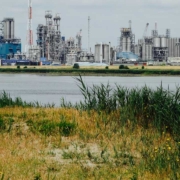Future supply chains. The untamed economy.
DHL has conducted an extensive study into future scenarios of its supply chain. Join the discussion in this article series [5] about the developments of the [Dutch] economy and the logistics implications.
Starting point.
More than ever, the world is driven by materialism. The paradigm of eternal growth has entered the world. The level of consumerism is rising to unprecedented heights. The untamed economy is booming.
Effects
Trade barriers have been removed and global trade volume has increased by 40%. Tackling and controlling the climate problem has completely failed. In this setting, the ’emerging countries’ have matured and the western countries saw their economies largely stall. The center of the financial world has moved to Asia. A global logistics supergrid has arrived that is able to bring products to consumers with highly innovative solutions. This untamed economy is ravaged by severe natural disasters due to the uncontrolled climate, disrupting continuous supply chains. Deep sea and arctic exploration is in full swing, depleting the last remaining resources.
Implications for supply chains.
Due to the enormous economic growth, especially in Asia and South America, both global and local players can benefit from unrestrained consumerism. Air and sea freight benefit the most from these developments. Production is located near the actual sales centers around the world. The advantage of the earlier outsourcing no longer applies due to the disappearance of wealth. A high degree of specialization is emerging in this world. Specific S&OP organizations that predict their supply chain for purely production-driven companies. Separate logistics service providers that focus purely on warehouse or distribution, in which further specialization is also possible. The ‘one offers all’ principle has been abandoned, partly because transport has become extremely expensive due to the high energy prices. Sustainable solutions are not given a chance due to a lack of international political will.
The biggest challenge for the supply chain is the devastating effects of natural disasters that are amplified by sharply rising average climate temperatures. Local infrastructures are regularly destroyed. As a result, the financial risks are considerably higher, which means that logistics organizations are confronted with a high Capital Cost.
The eroding of existing raw material supplies is slowly starting to lead to recycling. Repair and return services are strongly emerging. Social infrastructure is becoming unaffordable due to the strong aging population in Western countries and high global labor mobility. Private organizations have jumped into the hole, but the high costs have created a hard divide in society, which regularly leads to social unrest.
What do you think?
Will the aforementioned effects really occur in an ‘untamed economy’. ? what do you think the effects will be for the Dutch logistics sector? As a guide, DHL has identified 14 key factors that are explained in this table. Join the discussion and comment below this article. How do you think the fourteen indicators will develop in an untamed economy?
Bron:
DHL Delivering Tomorrow. Logistics 2050. A Scenario Study. ISBN 978-3-920269-54-2.
publicatie onder schriftelijke toestemming van DHL Germany.








